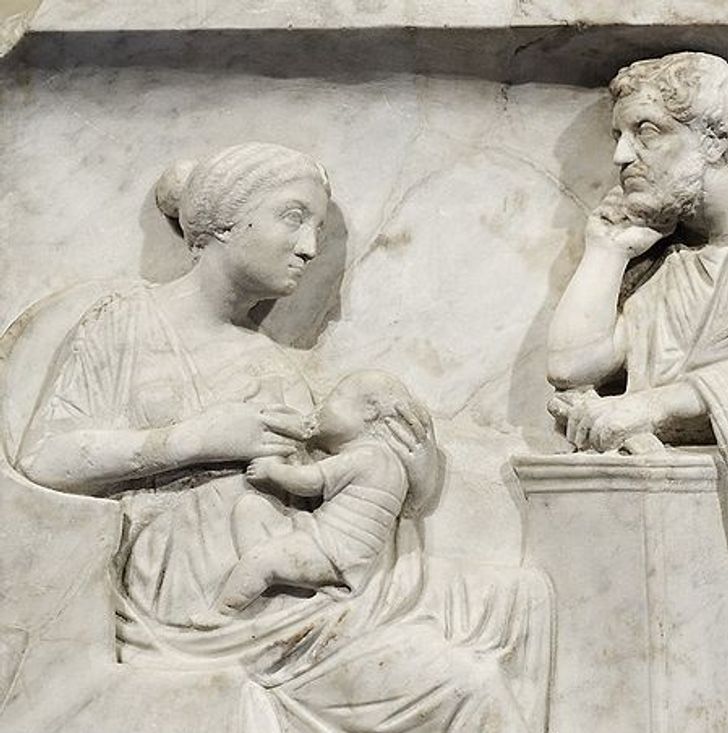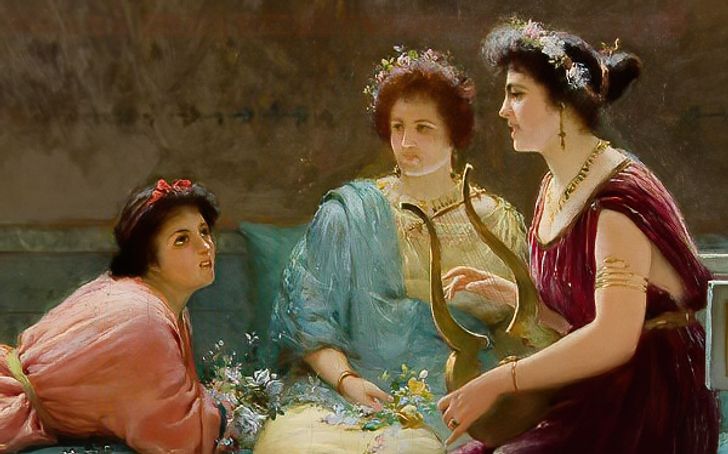That even after marriage the woman was to remain loyal to her Father, even above her husband.
Don't agree with it, but even for the times it's OTT.
10 Things Hollywood Movies Got Wrong About Women in Ancient Rome and Greece
Being a woman in Ancient Greece and Rome was not like being a woman today. Things we take for granted now were unavailable then. And it’s not just about rights and freedom but about more ordinary things as well.
They had to work a lot.
Generally speaking, the life of Roman women during the times of Emperor Augustus was not an easy thing. If a woman belonged to a lower social strata, she was less constrained in her movements than a woman from the elite part of society. However, they had to work more as well, like helping at farms, for example.
If a woman lived in town, she could become a midwife, a wet nurse, a hairdresser, a seamstress, an actress, a waitress, a cook, or she could entertain the Romans as a juggler or dancer. Women from the upper classes were in charge of housekeeping.
They had to be savvy during their periods.
Perhaps, in ancient times women’s periods were less frequent than today due to their diet. However, the Roman and Greek ladies hoped for an abundant discharge, as they feared that they might have bad consequences if the liquid remained inside.
As a rule, women would stay at home during periods and put cotton, sheep wool, or rags between their legs that were later washed and used again. Also, scientists believe that women who had their periods were wearing special pants called — subligaculum.
A woman needed to leave home for 3 days to get rid of her husband.
In those days, there were 3 types of marriages according to archaic Roman law: “confarreatio,” which was a marriage between Patricians or high-class Romans, and the second type was called “coemptio,” marriage by purchase.
And the third type was known as “usus” by mutual cohabitation — a woman who lived in her de facto husband’s home for one year was recognized as his legal wife. Therefore, in marriage by usus, if a woman was absent for 3 consecutive nights at least once a year, she would avoid her husband establishing legal control over her.
They had to go to baths to have a chat.
Compared to other ancient cities, hygiene in ancient Rome was at a fairly high level. The city had a well-developed sewage system, public toilets, and baths that kept Roman people from smelling bad, however, the benefits they brought were pretty dubious as well as public places were a perfect place to catch diseases. That’s why a Roman woman had to be very cautious when visiting the baths.
However, there were positive sides as well. Baths were a kind of get-together place. Roman women visited them to talk to their friends, to listen to poems, and meet their lovers. Although it was not common for men and women to bathe together in Rome, later Bishop Augustus forbade women to bathe naked at all. Even in the bathhouse, the Roman ladies had to wear special togas.
It was not common to breastfeed.
Wealthy Roman women did not breastfeed their kids. Newborns were handed over to their wet- nurses. Soranus, a powerful doctor of those times, figured that a mother was too exhausted after childbirth to breastfeed a kid.
Also, this Roman doctor believed that one of the advantages of getting a Greek wet nurse is that she could transfer the gift of her native language to the baby together with her milk.
They had to get married very early.
On average, Roman girls married at the age of 12 to their early twenties, but noblewomen went down the aisle even earlier. According to archaic Roman law, the oldest living man was the head of the family and had absolute power over his children.
He had the right to agree on the marriage of a daughter or son long before they reached the required age. However, a daughter could refuse marriage if she was able to prove that the potential husband had a bad character.

While Greek women often sported long, wavy hair, the married ones wore their hair up in bunches. Connected eyebrows were also considered beautiful in ancient Greece. Aside from that, Helen of Troy was described as having fairer skin. According to Greek mythology, she was the most beautiful woman in Greece, so it makes sense that her appearance matched the existing beauty ideals of the period.
Free morals were not that free.
In general, Ancient Rome was famous for its free morals. And although marriages based on mutual love did exist, Roman poets more often were extolling the relationship between lovers. At the same time, it was men who would most often get a lover because cheating, from a woman, was considered inappropriate.
The state would interfere in close relationships only if the union was a threat to someone’s status quo. However, there were times in the history of Rome when female treason was followed by criminal punishment.
The father was the head, even after marriage.
In the early Roman Empire, a daughter would stay under her father’s power even after getting married and her husband didn’t have any legal power over her. It was expected from a daughter that she would remain faithful to her father even if that meant going against her husband’s will. Also, a woman would retain her maiden surname after getting married.
They had to use non-standard cosmetic ingredients.
Women of Ancient Rome took good care of themselves. Pale and pure skin was a trend in those times. Lanolin, a substance obtained from sheep’s wool, was one of the popular recipes for masks. At the same time, the smell was not nice and men often complained about it. Roman women also used other strange ingredients such as plant juices, animal dung, sulfur, vinegar, ground oyster shells, onions with bird fat, and donkey milk.
Wealthy women used crocodile dung and snail ash for whitening their skin. Romans would also make artificial teeth from ivory.
Women didn’t have personal names.
For the most part during the history of Ancient Rome, women did not have their own names. They were named according to the clan they belonged to (Cornelia came from the gens, Cornelia). If a family had several daughters, a cognomen, such as Tertia (third), could indicate birth order. Also, newborn girls were named according to their father’s name (Vipsania, the daughter of Vipsanius).
Later, a girl was given 2 names by combining the surname of her father and the name of the place where she was born. In late antiquity, girls were often named after their mothers or other female relatives, who, in turn, were often named after saints.
Which elements from the past seem most incredible to you?
Comments
Related Reads
Brad Pitt’s Chin Transformation Leaves Fans Shocked, “He Looks Really Healthy Now”

15 People Whose Day Was Ruined by a Dramatic Fail

19 Сhefs Who (Learned to) Stay Calm No Matter How Crazy a Customer’s Request Is

17 People That Can’t Even Boil Eggs Without Ruining Them

15 Outfits From Fashion Designers That Made Our Jaws Drop

18 Transformations That Prove Surgeons Are Literally Magicians

People Shared 15+ Tales From Work That Are Either Witty, Hilarious, or Downright Infuriating

11 Kids Who Did Things That Left Their Parents Stunned

A Woman Avoids a Potential Stalker by Following Safety Advice She Read Online

What Happens If Someone Objects at Your Wedding

I Refused to Take My Stepdaughter to the Doctor After Discovering Her Secret

15+ Stories That Prove Moms’ Love Tank Never Runs Empty









